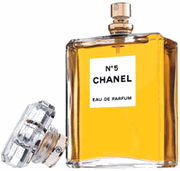Readers of this blog probably share my belief that agricultural biodiversity (ABD) is critical to our future. Economists have come up with elaborate concepts and numbers to value it. Scare scenarios abound, about the potential failure of genetically narrow crops jeopardizing the world’s food supply. (Luckily they haven’t materialized, for the most part). Yet most people seem to be thoroughly indifferent to ABD, to judge from the general unawareness and the uniformity of our consumption, through which every single day we decide against ABD. I have therefore always believed that unless we can connect people emotionally and positively to the cause of agricultural biodiversity, its conservation and use will be a difficult sell.
 One of the pillars of my belief has long been Chanel 5 perfume.
One of the pillars of my belief has long been Chanel 5 perfume.
Isn’t it derived from the Chanel 5 tree, also called ylang ylang? Botanically known as Cananga odorata, ylang ylang is a widely cultivated tree with heavily fragrant flowers, originally from Asia. Those flowers have ensured its spread around the tropics. Here in Cali, Colombia, where I live, the tree is common, and releases its sweet scent to perfume the balmy tropical nights. What better example could there be that agricultural biodiversity not only ensures our survival, but adds glamour and excitement to our lives?
That pillar received a devastating blow when a well-meaning colleague recently pointed out to me that Chanel 5 is a blend of entirely synthetic aldehydes, and has been since its launch in 1921. It actually epitomizes the industry’s break from a natural to a synthetic perfume model. I should have investigated more thoroughly. Indeed, I have since learned that perfumes nowadays are overwhelmingly made from synthetic sources and not at all as natural as you might conclude from the vocabulary experts use to describe fragrances.
However, I must come to the defense of the industry. Internet marketers of Chanel 5 do not hide the importance of aldehydes in the Chanel 5 fragrance. The nomenclatural equation of perfume and tree, as far as I can see, is mostly to blame on websites such as this, which seem unfaithfully to copy one another. (There is an excellent monograph on Cananga odorata — and loads of other species — at Agroforestry.net, but it too erroneously states that the flowers are the basis for Chanel 5 perfume.)
Which leaves me puzzling: how did the tree get its name? Was it simply because its smell happens to resemble the perfume? Or was Coco Chanel inspired by the tree’s fragrance, and then realized that it was cheaper and more reliable to base its production on synthetic chemistry? I am also worried: Are consumers sophisticated enough to appreciate the greater complexity of natural fragrances? If so, they might start once again to demand perfumes made of natural ingredients (as they had to in the past, before synthetics changed the industry), thus providing income opportunities to poor tropical producers?
Anyone out there to educate me on this?